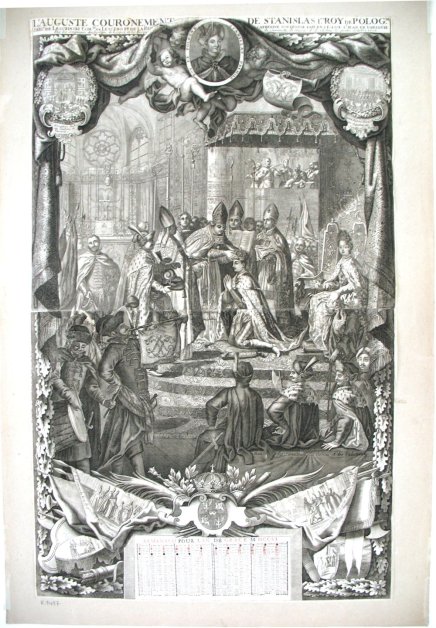
The Department of Prints and Engravings of the Princes Czartoryski Museum presents another exhibition of engravings from its collections. The portraits and scenes of celebrations and events are all linked to the reigns of two rial elected kings of Poland. The engravings displayed are the works of outstanding Dutch, Augsburg, and French artists of the 17th to 19th centuries.
After the death of king Jan III Sobieski, following a several-month long interregnum and a period of previously unheard-of corruption, an election was called which differed from all that had come before. For the first time, descendants of the dead king, that is of the local dynasty, were barred from candidacy. The king was elected by a minority, and what is more, a German was chosen, something which had heretofore in Poland been unthinkable. The nobility were divided into two opposing camps, each of which announced their candidate to be king. The Elector of Saxony, Friedrich Augustus I, was the quicker of the two and in September of 1697 was crowned August II, King of Poland. The coronation took place at Wawel Cathedral, and the royal insignia were acquired by forcing a hole through the wall of the locked treasury. The Elector converted to Catholicism, yet in royal portraits there appear the sash and star of the Danish Order of the Elephant, a distinction which he received as a Lutheran prince of the Reich; the star of the Order is also visible on the coronation robe of August II. Most likely, these portraits were intended to remind viewers that the king still retained his authority over the Lutheran Church in Saxony and that he was still the leader of the Evangelical delegates to the Imperial Diet. To obtain Livonia for the Wettins, he entered into an alliance with Russian tzar Peter the Great and began a war with Sweden. He underestimated the young king Charles XII, who was victorious in all the battles of this conflict and stubbornly demanded the removal of August II from the throne. It was in fact Charles XII who instigated the election and coronation (in 1705) of Stanisław Leszczyński. August II only abdicated in 1706, when the Swedish armies entered Saxony. The coronation of Leszczyński and his wife Katarzyna née Opalińska was immortalised in two wall calendars from the year 1706, engraved in Paris almost certainly on the order of the court at Versailles. After the defeat of the Swedes at the Battle of Poltava in 1709, August II helped the tzar Peter I regain his throne, and Stanisław Leszczyński went into banishment. The portrait of August II by Pieter Schenck includes elements which refer back to this victory over Leszczyński, including a broken sceptre, a crown lying on a battlefield, and an abandoned standard with the coat-of-arms of the Wieniawa clan. After the tragic death of Charles XII, Leszczyński took up residence in Lorraine. There he vegetated, devoid of support and influence, until the year 1725 when his daughter Maria married the king of France, Louis XV. From that time on, his royal coat-of-arms was surrounded by the collars of the orders of St Michael and the Holy Spirit, while Leszczyński himself, now as the father-in-law of the king of France, once again began his attempts to regain the throne of Poland. In 1733, Leszczyński made a secret trip to Warsaw and was elected king with a majority of votes. Meanwhile, Russian armed forces organised the election of August III in Prague. Leszczyński departed for Gdańsk, to await French reinforcements there. Gdańsk put up stiff resistance to the Russian and Saxon siege for four months. Just before the capitulation of the city, Leszczyński fled the city by night, dressed in a costume. After his abdication in 1736, he received in compensation lifetime rulership of the duchies of Lorraine and Bar. The accession to the Dukedom is illustrated by two wall calendars from 1738, commissioned by the court at Versailles. In the main scene of one of these, the ceremonial baptism of the dauphine of France, the seven-year-old grandson of Leszczyński, is shown. Stanisław Leszczyński remained the titular king of Poland. A patron of the arts, literature, and science, he was known as the Benefactor King and the Philosopher King. He expanded the city of Nancy, and his palace at Lunéville was believed to be even more beautiful than Versailles. The memory of king Stanisław remained strong in France for many years, as can be seen from the engraving dedicate to him with a bouquet of carnations.
Barbara König
